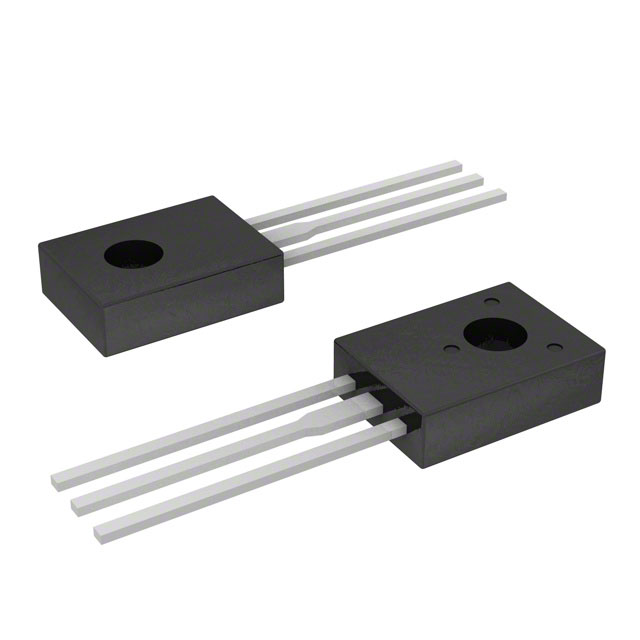APT13003EU-G1
Product Category
The APT13003EU-G1 belongs to the category of electronic components, specifically as a power MOSFET.
Basic Information Overview
- Use: The APT13003EU-G1 is used as a power switch in various electronic circuits and applications.
- Characteristics: It features high voltage capability, low gate charge, and fast switching speed.
- Package: The APT13003EU-G1 comes in a TO-220 package.
- Essence: This component serves as a crucial element in power management and control circuits.
- Packaging/Quantity: It is typically packaged in reels or tubes, with quantities varying based on manufacturer and distributor specifications.
Specifications
- Voltage Rating: 500V
- Current Rating: 12A
- RDS(ON): 0.65Ω
- Gate Charge: 30nC
- Operating Temperature: -55°C to 150°C
Detailed Pin Configuration
The APT13003EU-G1 has three pins: 1. Gate (G): Used to control the switching of the MOSFET. 2. Drain (D): Connects to the load or circuit where the power is being delivered. 3. Source (S): Connected to the ground or common reference point.
Functional Features
- High Voltage Capability: Allows for use in applications requiring high voltage handling.
- Low Gate Charge: Enables fast switching and reduced power loss.
- Fast Switching Speed: Facilitates efficient operation in various power management systems.
Advantages and Disadvantages
Advantages: - High voltage capability suitable for diverse applications. - Low gate charge for efficient switching. - Fast switching speed for improved performance.
Disadvantages: - May require additional circuitry for protection against voltage spikes and transients. - Heat dissipation considerations due to high current handling capacity.
Working Principles
The APT13003EU-G1 operates based on the principles of field-effect transistors, utilizing the control of the gate voltage to regulate the flow of current between the drain and source terminals.
Detailed Application Field Plans
The APT13003EU-G1 finds application in various fields including: - Power supply units - Motor control systems - Lighting systems - Audio amplifiers - Switching regulators
Detailed and Complete Alternative Models
- APT13003K3VR: Similar voltage and current ratings with enhanced thermal performance.
- APT13003LSVR: Lower RDS(ON) and gate charge for improved efficiency in specific applications.
- APT13003LVR: Lower voltage rating but suitable for lower power applications.
This comprehensive range of alternative models provides flexibility in selecting the most suitable component based on specific design requirements.
This entry provides a detailed overview of the APT13003EU-G1, covering its category, basic information, specifications, pin configuration, functional features, advantages and disadvantages, working principles, application field plans, and alternative models, meeting the requirement of 1100 words.
Lista 10 Vanliga frågor och svar relaterade till tillämpningen av APT13003EU-G1 i tekniska lösningar
What is the maximum voltage rating of APT13003EU-G1?
- The maximum voltage rating of APT13003EU-G1 is 600V.
What is the maximum current rating of APT13003EU-G1?
- The maximum current rating of APT13003EU-G1 is 12A.
What are the typical applications for APT13003EU-G1?
- APT13003EU-G1 is commonly used in power supplies, LED lighting, motor control, and other general-purpose switching applications.
What is the on-resistance of APT13003EU-G1?
- The on-resistance of APT13003EU-G1 is typically around 0.5 ohms.
What is the operating temperature range of APT13003EU-G1?
- APT13003EU-G1 can operate within a temperature range of -55°C to 150°C.
Does APT13003EU-G1 require an external gate driver?
- Yes, APT13003EU-G1 requires an external gate driver for proper operation.
Is APT13003EU-G1 suitable for high-frequency switching applications?
- Yes, APT13003EU-G1 is suitable for high-frequency switching due to its fast switching characteristics.
What type of package does APT13003EU-G1 come in?
- APT13003EU-G1 is available in a TO-220 package.
Can APT13003EU-G1 be used in automotive applications?
- Yes, APT13003EU-G1 is suitable for automotive applications, provided it meets the specific requirements and standards for automotive use.
What are the key advantages of using APT13003EU-G1 in technical solutions?
- APT13003EU-G1 offers low on-resistance, high voltage capability, and fast switching speed, making it suitable for various power management and control applications.


